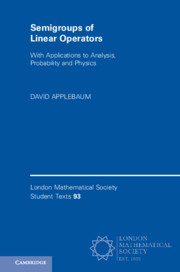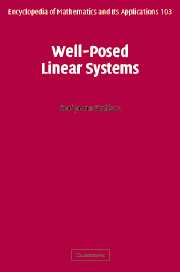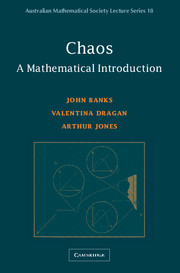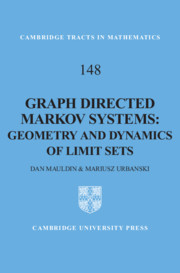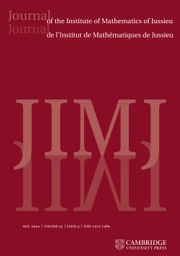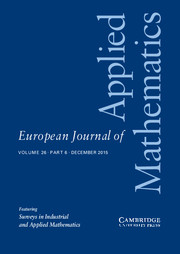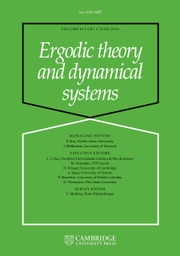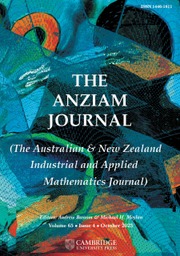Randomness and Recurrence in Dynamical Systems
A Real Analysis Approach
£39.99
Part of Carus Mathematical Monographs
- Author: Rodney Nillsen
- Date Published: November 2010
- availability: This item is not supplied by Cambridge University Press in your region. Please contact Mathematical Association of America for availability.
- format: Hardback
- isbn: 9780883850435
£
39.99
Hardback
Looking for an inspection copy?
This title is not currently available on inspection
-
Randomness and Recurrence in Dynamical Systems makes accessible, at the undergraduate or beginning graduate level, results and ideas on averaging, randomness and recurrence that traditionally require measure theory. Assuming only a background in elementary calculus and real analysis, new techniques of proof have been developed, and known proofs have been adapted, to make this possible. The book connects the material with recent research, thereby bridging the gap between undergraduate teaching and current mathematical research. The various topics are unified by the concept of an abstract dynamical system, so there are close connections with what may be termed 'Probabilistic Chaos Theory' or 'Randomness'. The work is appropriate for undergraduate courses in real analysis, dynamical systems, random and chaotic phenomena and probability. It will also be suitable for readers who are interested in mathematical ideas of randomness and recurrence, but who have no measure theory background.
Read more- An emphasis on possible interpretations of certain results and concepts, and their connections to other areas of inquiry, gives the reader a depth of understanding
- Includes both 'Exercises' and 'Investigations': the former emphasise more technical questions concerning the ideas, while the latter are more open, allowing scope for student initiative and further research
- Notes at the end of each part set the mathematical ideas in their historical background
Customer reviews
Not yet reviewed
Be the first to review
Review was not posted due to profanity
×Product details
- Date Published: November 2010
- format: Hardback
- isbn: 9780883850435
- length: 374 pages
- dimensions: 215 x 143 x 25 mm
- weight: 0.54kg
- availability: This item is not supplied by Cambridge University Press in your region. Please contact Mathematical Association of America for availability.
Table of Contents
Introduction:
1. Origins, approach and aims of the work
2. Dynamical systems and the subject matter
3. Using this book
Part I. Background Ideas and Knowledge:
4. Dynamical systems, iteration, and orbits
5. Information loss and randomness in dynamical systems
6. Assumed knowledge and notations
Appendix: mathematical reasoning and proof
Exercises
Investigations
Notes
Bibliography
Part II. Irrational Numbers and Dynamical Systems:
7. Introduction: irrational numbers and the infinite
8. Fractional parts and points on the unit circle
9. Partitions and the pigeon-hole principle
10. Kronecker's theorem
11. The dynamical systems approach to Kronecker's theorem
12. Kronecker and chaos in the music of Steve Reich
13. The ideas in Weyl's theorem on irrational numbers
14. The proof of Weyl's theorem
15. Chaos in Kronecker systems
Exercises
Investigations
Notes
Bibliography
Part III. Probability and Randomness:
16. Introduction: probability, coin tossing and randomness
17. Expansions to a base
18. Rational numbers and periodic expansions
19. Sets, events, length and probability
20. Sets of measure zero
21. Independent sets and events
22. Typewriters, recurrence, and the Prince of Denmark
23. The Rademacher functions
24. Randomness, binary expansions and a law of averages
25. The dynamical systems approach
26. The Walsh functions
27. Normal numbers and randomness
28. Notions of probability and randomness
29. The curious phenomenon of the leading significant digit
30. Leading digits and geometric sequences
31. Multiple digits and a result of Diaconis
32. Dynamical systems and changes of scale
33. The equivalence of Kronecker and Benford dynamical systems
34. Scale invariance and the necessity of Benford's law
Exercises
Investigations
Notes
Bibliography
Part IV. Recurrence:
35. Introduction: random systems and recurrence
36. Transformations that preserve length
37. Poincaré recurrence
38. Recurrent points
39. Kac's result on average recurrence times
40. Applications to the Kronecker and Borel dynamical systems
41. The standard deviation of recurrence times
Exercises
Investigations
Notes
Bibliography
Part V. Averaging in Time and Space:
42. Introduction: averaging in time and space
43. Outer measure
44. Invariant sets
45. Measurable sets
46. Measure-preserving transformations
47. Poincaré recurrence … again!
48. Ergodic systems
49. Birkhoff's theorem: the time average equals the space average
50. Weyl's theorem from the ergodic viewpoint
51. The Ergodic Theorem and expansions to an arbitrary base
52. Kac's recurrence formula: the general case
53. Mixing transformations and an example of Kakutani
54. Lüroth transformations and continued fractions
Exercises
Investigations
Notes
Bibliography
Index.
Sorry, this resource is locked
Please register or sign in to request access. If you are having problems accessing these resources please email lecturers@cambridge.org
Register Sign in» Proceed
You are now leaving the Cambridge University Press website. Your eBook purchase and download will be completed by our partner www.ebooks.com. Please see the permission section of the www.ebooks.com catalogue page for details of the print & copy limits on our eBooks.
Continue ×Are you sure you want to delete your account?
This cannot be undone.
Thank you for your feedback which will help us improve our service.
If you requested a response, we will make sure to get back to you shortly.
×



